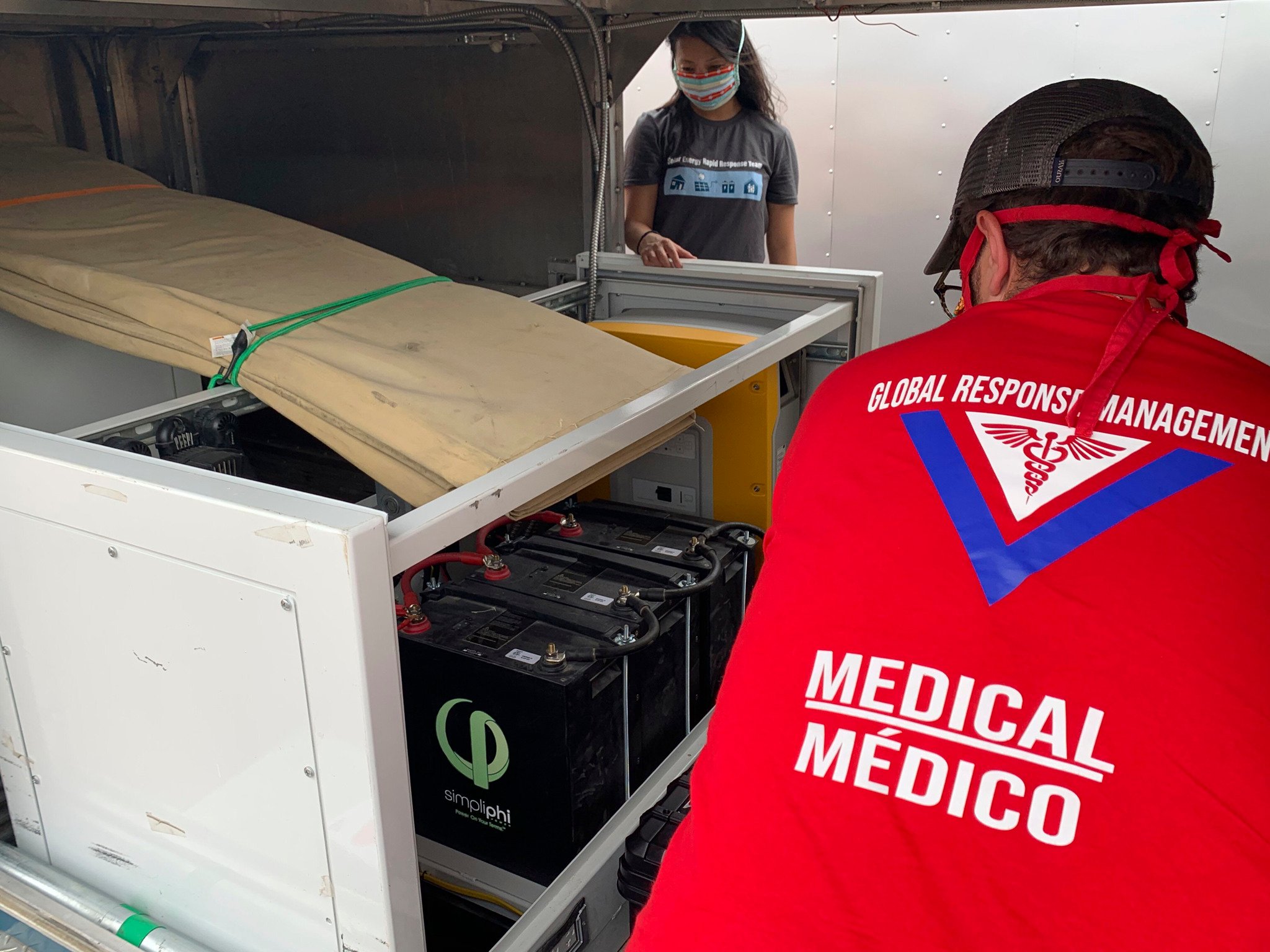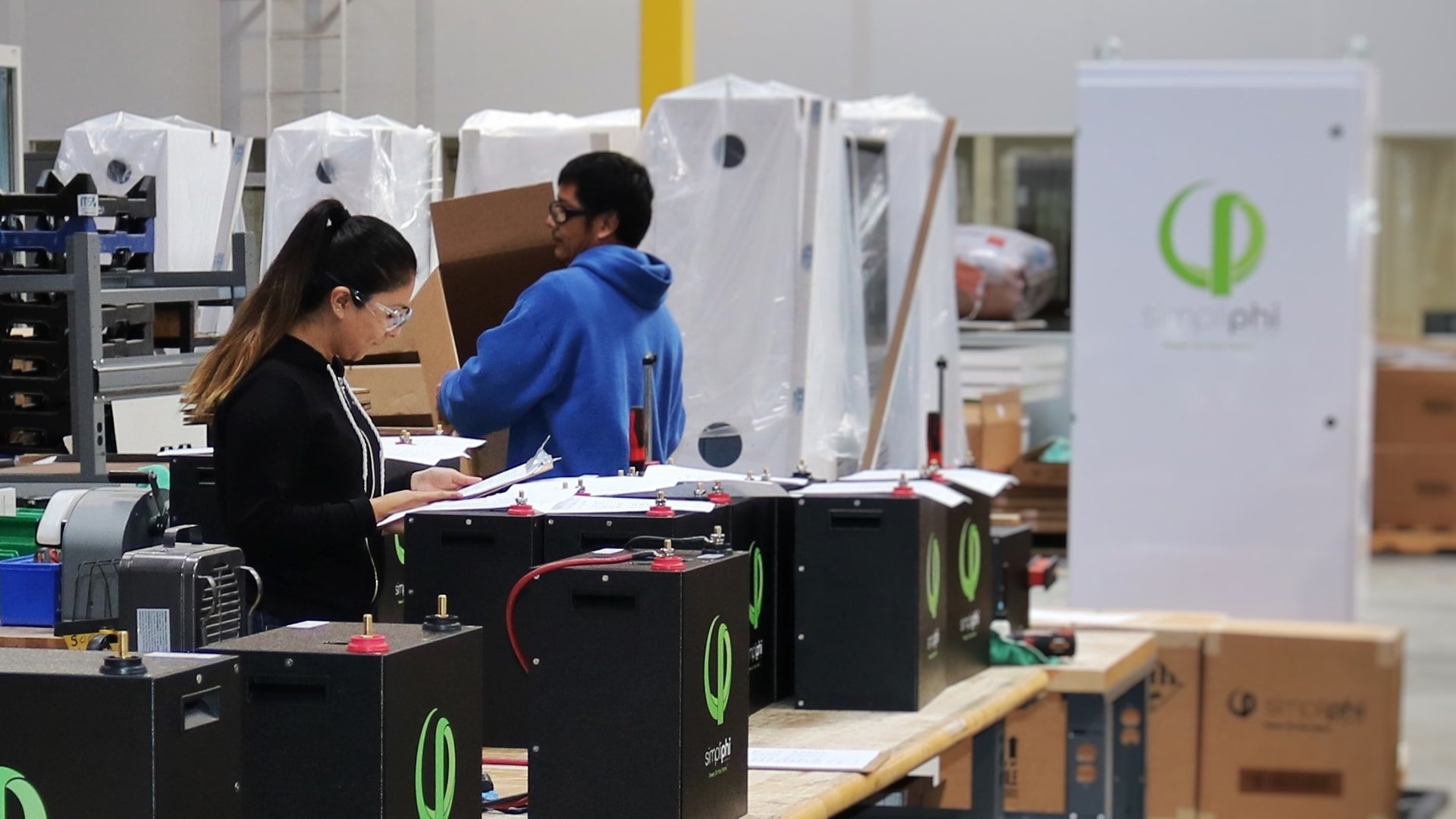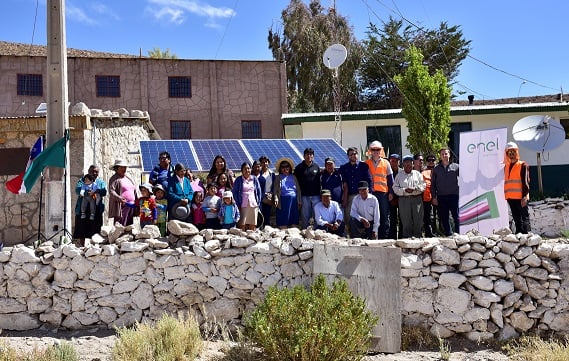It’s one of the more compelling backstories you’ll come across in the energy storage industry. Inspired by the potential of technological advancements to help humanity, CEO Catherine Von Burg, a biomedical engineer teams up with CTO Stuart Lennox, a film and television production designer whose portable battery-powered solutions have been used on-set in movies like Avatar and Tron Legacy.
From those cinematic beginnings, the pair have developed a battery storage company aimed at bringing safe, reliable and clean power to the masses. The product range spans from portable packs to solar home systems up to high voltage commercial and industrial (C&I) units, deployed everywhere from multi-home virtual power plants, to farms, to a pop-up COVID clinic at the US-Mexico border.
SimpliPhi Power has made some bold choices in the decade that the company has been active. From picking lithium iron phosphate (LFP) battery chemistry very early on, to offering discounts on their products to customers across America affected by wildfires and other vulnerabilities in their electricity supply, the company has focused on leveraging key technologies to “satisfy different pain points around energy for different types of populations and requirements, globally,” according to Von Berg. Energy-Storage.news spoke with SimpliPhi’s CEO to learn more about some of those bold choices.
SimpliPhi had a long background in providing mobile power solutions and it caught a lot of people’s attention that that included movie sets. What drove the thinking to go from doing that sort of project-by-project bespoke solution to creating a mass market proposition for battery storage?
Try Premium for just $1
- Full premium access for the first month at only $1
- Converts to an annual rate after 30 days unless cancelled
- Cancel anytime during the trial period
Premium Benefits
- Expert industry analysis and interviews
- Digital access to PV Tech Power journal
- Exclusive event discounts
Or get the full Premium subscription right away
Or continue reading this article for free
Certainly in 2010, when SimpliPhi started up no one was really thinking about batteries, to too much extent. Personally, my background is in biomedical engineering and in my view, technology needs to make an impact for the better in people’s lives.
Even in 2010, looking at rising energy costs and the rising level of CO2 and greenhouse gas emissions generally, our goal was to think about: “How can we help push the energy transition toward a more sustainable, cleaner future?” As lofty as that sounds, it was a very pragmatic question. What were some of the biggest pain points around people’s relationship to energy, whether they were on-grid or off-grid?
In 2010, the World Health Organisation estimated there were approximately 1.2 to 1.3 billion people that were marginalised simply because they did not have access to power (today it’s still around 900 million – Editor). There were approximately another 1.3 or so billion [people] that had intermittent access to power. And if we think about sustainability, people were burning rubber and garbage and any kind of asset they could, which also added to the toxicity.
Then also empowerment: whether it’s the 1.2 billion that lived beyond the grid, or people who were on the grid, paying ever-increasing charges for energy, paying for nuclear power plants that never came online but it’s in their energy bill… giving people the power to make decisions around what the generation source is and being able to have power when and where they needed it. As well as the excessive generation going on at peaker plants that run at peak times — and sometimes only 20% of what’s being generated is being utilised — that has a huge impact on co2 levels.
So it was all of those kinds of issues that really fed into founding the company when I met our CTO, Stuart Lennox, looking at these mobile portable systems. It was very ‘sexy’ for the movie industry. But for me, it was leveraging that platform technology and beginning to scale it up and to satisfy different pain points around energy for different types of populations and requirements, globally.
So why the decision to go for lithium iron phosphate (LFP) very early on?
In 2010 when we founded, the predominant battery chemistry for lithium-ion was lithium cobalt oxide. As the industry progressed, other rare earth elements were added in like manganese, nickel and others, to further mitigate a fundamental hazard with cobalt.
Early on, we had done testing across different types of cells. Chemistry matters, form factor matters. Whether they’re cylindrical cells, prismatic, or pouch. From our viewpoint, we were really focused on safety. Because we were looking to leverage energy storage to create energy security and if you use a fundamentally toxic and hazardous chemistry, how can you talk about safety, even resilience, using batteries that put the end user at risk?
In addition to that, we were really committed to shifting to a cleaner energy future. That also meant we could not consider a toxic hazardous battery — why store clean energy in toxic batteries? So those issues were central to why we chose LFP. It was based on rigorous testing at our own facility across chemistries and all the different form factors that that chemistry is packaged in. Even if you don’t care about supply chain issues, the toxicity along that supply chain, or even if you don’t care about the child labour that a lot of larger companies are coming under fire for – which we do [care about] – issues around the safety are critical.
What was a central issue for us then, is still a central issue in the market today and is playing out. And that’s really why we’ve [also] been supportive of any efforts to create consumer safety around battery storage, like UL9540 and UL9540A testing.

From movie sets to the military
How did you establish an effective supply chain as a startup in an industry where so many big companies were your competitors?
LFP was originated by Dr. John Goodenough out of UT Austin, Texas. Initially, that patent was given to only a handful of manufacturers globally that were allowed to take that innovation and build and improve upon it. Because of Dr. Goodenough, who I was on the phone with, talking with him and finding out who has licensed that technology, working with those early adopters, we were able to develop relationships and began to request different types of cells and test them against some of the performance requirements profile we were looking for in terms of safety, longevity, the cycle life and creating robust batteries.
For example, in 2010-11, the US military came to us. They had all but banned lithium-ion batteries, because again, it was the lithium cobalt oxide (LCO), nickel manganese cobalt (NMC), the nickel cobalt aluminium (NCA) and they had fires, explosions, failures and that ban created real problems, because they were also struggling with lead acid batteries that were dead on arrival by the time they arrived at forward operating bases in Afghanistan or Iraq.
So in the early days we were looking for performance profiles on a cell basis, but also constructing a battery pack — that was our innovation. We worked in lockstep with these early cell manufacturers so we have a very deep understanding of the chemistry and relationships with cell manufacturers all over the world. That positioned us when the military came to us to create very robust batteries, using the LFP with high energy density, and long cycle life, and an enormous amount of ability to discharge quickly.
We were able to combine power and energy in one battery that the US Army and Marine Corps tested and put our batteries through rigorous [use] and proved out the efficacy of the technology. Initially the military came out with a mandate that was very aggressive, more so than our own government. Getting off of fossil fuels was a matter of national security, for the Marine Corps, the Army, the Air Force.
They were struggling with diesel generators and the enormous amount of manpower used to just protect convoys. Our batteries initially were just paired with generators. Our whole goal was to optimise the generators so that our batteries can be charged up in an hour, the generator shuts off creating mobile systems so men and women could then be stealth. It took the heat footprint away, the sound and it allowed for reconnaissance and other types of missions, using our batteries and folding solar panels.
Then we began to develop the expertise in the solar panels, nano grids and micro grids. That was really the early days. We were designing for the military on forward operating bases primarily in Afghanistan and Iraq and we had begun to work with other agencies and anti-drug and human trafficking in South and Central America, and it goes on from there. But as exotic as all of that sounds, those applications have direct relevance to the markets we sell into that are commercial and residential on-grid and off-grid.
That’s quite a journey really, isn’t it?
Especially because our CTO, Stuart Lennox, he’s a Quaker by how he affiliates. And Quakers are pacifist. And when we founded the company, never did we think we would be working with the military and our services. It was really thinking about people who are marginalised, removing intermittency, creating independence from the grid, or certainly [creating] security, if you’re grid-tied. But the truth is the military were fundamental to giving us the opportunity to prove out the technology, the safety, the cycle life, the rigorous and austere use cases, or austere environments that our batteries were subjected to.
In 2014, we received a report from the US Army: zero failure rates. And they were watching, because they had banned all the lithium-ion batteries. Today in the market there is still is a lack of differentiation around chemistry, and why chemistry matters. And around the form factor, like pouch and prismatic. Pouch, regardless of the chemistry, creates all sorts of risks. We’ve been trying to really educate the market and consumers on this issue, because chemistry really does make a difference in safety, and certainly in hazards.
From those proof points and creating the products that you now have, from portable devices to residential and commercial-scale systems, where do you see the market today and going forwards?
In 2020 with the advent of COVID shutdowns and globally an economic downturn, we didn’t really know what to expect – no one did – when the shutdowns began to take place.
After rearranging our manufacturing and creating safety protocols, when we opened back up, we saw over the remainder of the year, a little over a 40% increase in demand from 2019, and even the beginning of the first quarter of this year. Throughout the year, demand kept growing and growing.
In 2010 storage was looked at for off-grid, for access to energy 24/7, using off-grid solar or other generation sources coupled with batteries. It was a real priority to resolve the intermittency of renewables. Today, that intermittency is as applicable today for grid infrastructure, grid failures. And certainly even planned outages, is as much an issue today as it was in 2010, for renewables.
What we began to see is that people are becoming very, very aware of the vulnerability that they have as a result of top-down centralised generation, transmission and distribution. These centralised distribution systems were failing. As it was with personal protection equipment (PPE), as it was with food. Then of course with energy, specifically California, as a case in point, the wildfires. All over the world, we’ve seen billions of dollars in losses because of the catastrophic impact of fires, and that’s property destruction. We have climate refugees here in the US and all over the world, people who have lost their homes, lost whole towns and communities. And economic losses.
That sense of vulnerability, of being dependent on a distribution system, that in the case of energy is not only breaking down and failing but also putting people at risk and having to be shut off. That all translated into kind of a groundswell globally, for a demand to create resilience at the customer site.

Batteries are building blocks
You’ve been very vocal about how Californians should deserve better than the Public Safety Power Shutoffs (PSPS) many have experienced, and SimpliPhi products are offered at a discount to those in California and elsewhere affected by critical resiliency issues. One thing we often hear is that fossil fuel generators are still way cheaper as backup than battery storage for upfront cost. What’s the competitive advantage of batteries?
Our company in 2017, went through fire evacuations. Our entire company shut down, evacuated for over a week. Ultimately, the town had to be evacuated again, because it looked like the ring of mountains around the town were all on fire and coming down rapidly.
If you’ve been in an evacuation area where there are fires going on and people have generators, very often you’re being choked by smoke from the fires anyway and it’s raining ash. Then you have all these generators, in a parking lot, or even a hospital or clinic or an emergency setup. It’s choking, the noise is deafening.
And very often when you have fires or power outages or any kind of catastrophic situation like earthquakes, tornadoes, fuel is hard to get, and gas stations aren’t pumping. It ends up choking people off from feeding their generators, as well as choking them off in terms of air pollution and the noise.
This is one of the reasons why as a company, early on, we have had portable products. And we now have a product called the Express, which we call [a] mobile battery generator on wheels. It’s the idea that you take your power with you. If you don’t want to hardwire an energy storage system into your home, or you want to hardwire but disconnect quickly and take it with you while you evacuate.
You don’t have to back up a whole home with batteries, you can think about what’s critical to you during a power outage and so just having a couple of batteries, a small system to power those critical loads and outlets with lights, your laptops, cell phones, your refrigerator, whatever it is.
Being able to scale up systems is another principle behind our technologies. We look at batteries as building blocks. And so to be able to add to those systems, scale up over time, add to the system, as your budget allows, or your energy requirements grow, etc. That’s true of homeowners and commercial and industrial customers as well.
Battery storage can provide resilience and backup power, as well as energy independence from the grid, but they can also do some important jobs on the grid as well, reducing the peak energy demand or providing grid services like frequency regulation.
What I think is interesting is this issue around grid infrastructure and how old it is, how vulnerable it is. The Town of Paradise that burned down in Northern California within a couple of hours in one of the most catastrophic fires in 2018, that fire was started by transmission lines that were over 75 years old.
The cost for upgrading grid infrastructure is in the billions and there is a massive delta between what is available for infrastructure upgrades and what it’s going to actually cost.
If grids continue to fail because of how old the infrastructure equipment is and it needs to be upgraded, if we’re constantly adding new technology and sophisticated technology at the customer site, or at the customer point of entry to the grid, ultimately that in itself is going to continue to push towards distributed solutions rather than large centralised. Given the cost of infrastructure upgrades, you look at the cost of building in resilience in generation: rooftop to rooftop, home to home, business to business, community, hospitals, school, whatever it is, the cost is so much more manageable for distributed assets that actually relieve the overall load on the grid.
We are not and really have never been interested in multi megawatt-hour utility-scale projects. Because whether it’s a peaker plant, or gas or whatever the power plant is, or even a large battery, those large centralised resources are dependent on the same transmission and distribution lines that are failing.

